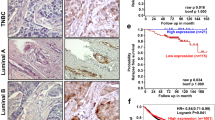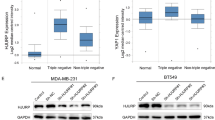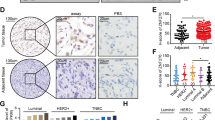Abstract
Due to the complexity and heterogeneity of breast cancer, the therapeutic effects of breast cancer treatment vary between subtypes. Breast cancer subtypes are classified based on the presence of molecular markers for estrogen or progesterone receptors and human epidermal growth factor 2. Thus, novel, comprehensive, and precise molecular indicators in breast carcinogenesis are urgently needed. Here, we report that ZNF133, a zinc-finger protein, is negatively associated with poor survival and advanced pathological staging of breast carcinomas. Moreover, ZNF133 is a transcription repressor physically associated with the KAP1 complex. It transcriptionally represses a cohort of genes, including L1CAM, that are critically involved in cell proliferation and motility. We also demonstrate that the ZNF133/KAP1 complex inhibits the proliferation and invasion of breast cancer cells in vitro and suppresses breast cancer growth and metastasis in vivo by dampening the transcription of L1CAM. Taken together, the findings of our study confirm the value of ZNF133 and L1CAM levels in the diagnosis and prognosis of breast cancer, contribute to a deeper understanding of the regulation mechanism of ZNF133 for the first time, and provide a new therapeutic strategy and precise intervention target for breast cancer.
This is a preview of subscription content, access via your institution
Access options
Subscribe to this journal
Receive 50 print issues and online access
$259.00 per year
only $5.18 per issue
Buy this article
- Purchase on Springer Link
- Instant access to full article PDF
Prices may be subject to local taxes which are calculated during checkout








Similar content being viewed by others
Data availability
ChIP-seq data for ZNF133 has been deposited in the Gene Expression Omnibus (GEO) with an accession number GSE226190. Data for Kaplan–Meier survival analysis in breast cancer patients are publicly available online at http://kmplot.com/analysis/index.php?p=background. Data for Gene expression-based Outcome for Breast cancer Online (GOBO) analysis are available from http://co.bmc.lu.se/gobo/gsa.pl. Data for Gene Expression Profiling Interactive Analysis (GEPIA) analysis are available from http://gepia.cancer-pku.cn/. Data for mRNA expression analysis in breast cancer patients are available in the Oncomine database at https://www.oncomine.org/. Access to publicly available cancer TCGA data is provided in the UALCAN web resource at http://ualcan.path.uab.edu/index.html. The open reading frame, conserved domains, and chromosomal location of ZNF133 were analyzed using the Uniprot (https://www.uniprot.org/) and NCBI (www.ncbi.nlm.nih.gov) databases. The theoretical molecular weight of ZNF133 was calculated using http://www.detaibio.com/sms2/protein_mw.html tools. The homologous alignment and phylogenetic analysis were performed using the MegAlign with Clustal V method.
References
Siegel RL, Miller KD, Fuchs HE, Jemal A. Cancer statistics, 2021. CA Cancer J Clin. 2021;71:7–33.
Waks AG, Winer EP. Breast cancer treatment: a review. JAMA. 2019;321:288–300.
Tsang JYS, Tse GM. Molecular classification of breast cancer. Adv Anat Pathol. 2020;27:27–35.
Liang Y, Zhang H, Song X, Yang Q. Metastatic heterogeneity of breast cancer: Molecular mechanism and potential therapeutic targets. Semin Cancer Biol. 2020;60:14–27.
Loibl S, Poortmans P, Morrow M, Denkert C, Curigliano G. Breast cancer. Lancet. 2021;397:1750–69.
Cassandri M, Smirnov A, Novelli F, Pitolli C, Agostini M, Malewicz M, et al. Zinc-finger proteins in health and disease. Cell Death Discov. 2017;3:17071.
Sun M, Ju J, Ding Y, Zhao C, Tian C. The signaling pathways regulated by KRAB zinc-finger proteins in cancer. Biochim Biophys Acta Rev Cancer. 2022;1877:188731.
Shen AL, Moran SA, Glover EA, Drinkwater NR, Swearingen RE, Teixeira LB, et al. Association of a chromosomal rearrangement event with mouse posterior polymorphous corneal dystrophy and alterations in Csrp2bp, Dzank1, and Ovol2 gene expression. PLoS ONE. 2016;11:e0157577.
Ehringer MA, Thompson J, Conroy O, Goldman D, Smith TL, Schuckit MA, et al. Human alcoholism studies of genes identified through mouse quantitative trait locus analysis. Addict Biol. 2002;7:365–71.
Jung ES, Choi KW, Kim SW, Hubenthal M, Mucha S, Park J, et al. ZNF133 is associated with infliximab responsiveness in patients with inflammatory bowel diseases. J Gastroenterol Hepatol. 2019;34:1727–35.
Heiskanen MA, Bittner ML, Chen Y, Khan J, Adler KE, Trent JM, et al. Detection of gene amplification by genomic hybridization to cDNA microarrays. Cancer Res. 2000;60:799–802.
Li Y, Liang Q, Wen YQ, Chen LL, Wang LT, Liu YL, et al. Comparative proteomics analysis of human osteosarcomas and benign tumor of bone. Cancer Genet Cytogenet. 2010;198:97–106.
Dai X, Chen X, Hakizimana O, Mei Y. Genetic interactions between ANLN and KDR are prognostic for breast cancer survival. Oncol Rep. 2019;42:2255–66.
Andersen K, Smith-Sorensen B, Pedersen KB, Hovig E, Myklebost O, Fodstad O, et al. Interferon-gamma suppresses S100A4 transcription independently of apoptosis or cell cycle arrest. Br J Cancer. 2003;88:1995–2001.
Galetzka D, Muller T, Dittrich M, Endres M, Kartal N, Sinizyn O, et al. Correction to: molecular karyotyping and gene expression analysis in childhood cancer patients. J Mol Med. 2020;98:1657.
Kleene R, Lutz D, Loers G, Bork U, Borgmeyer U, Hermans-Borgmeyer I, et al. Revisiting the proteolytic processing of cell adhesion molecule L1. J Neurochem. 2021;157:1102–17.
Duncan BW, Murphy KE, Maness PF. Molecular mechanisms of L1 and NCAM adhesion molecules in synaptic pruning, plasticity, and stabilization. Front Cell Dev Biol. 2021;9:625340.
Ango F, Gallo NB, Van Aelst L. Molecular mechanisms of axo-axonic innervation. Curr Opin Neurobiol. 2021;69:105–12.
Zhang J, Yang F, Ding Y, Zhen L, Han X, Jiao F, et al. Overexpression of L1 cell adhesion molecule correlates with aggressive tumor progression of patients with breast cancer and promotes motility of breast cancer cells. Int J Clin Exp Pathol. 2015;8:9240–7.
Saha A, Cheriyamundath S, Kumar A, Gavert N, Brabletz T, Ben-Ze'ev A. A necessary role for increased biglycan expression during L1-mediated colon cancer progression. Int J Mol Sci. 2021;23:445.
Altevogt P, Doberstein K, Fogel M. L1CAM in human cancer. Int J Cancer. 2016;138:1565–76.
Chen J, Gao F, Liu N. L1CAM promotes epithelial to mesenchymal transition and formation of cancer initiating cells in human endometrial cancer. Exp Ther Med. 2018;15:2792–7.
Ben Q, An W, Fei J, Xu M, Li G, Li Z, et al. Downregulation of L1CAM inhibits proliferation, invasion and arrests cell cycle progression in pancreatic cancer cells in vitro. Exp Ther Med. 2014;7:785–90.
Er EE, Valiente M, Ganesh K, Zou Y, Agrawal S, Hu J, et al. Pericyte-like spreading by disseminated cancer cells activates YAP and MRTF for metastatic colonization. Nat Cell Biol. 2018;20:966–78.
Geismann C, Arlt A, Bauer I, Pfeifer M, Schirmer U, Altevogt P, et al. Binding of the transcription factor Slug to the L1CAM promoter is essential for transforming growth factor-beta1 (TGF-beta)-induced L1CAM expression in human pancreatic ductal adenocarcinoma cells. Int J Oncol. 2011;38:257–66.
Kreisler A, Strissel PL, Strick R, Neumann SB, Schumacher U, Becker CM. Regulation of the NRSF/REST gene by methylation and CREB affects the cellular phenotype of small-cell lung cancer. Oncogene. 2010;29:5828–38.
Doberstein K, Milde-Langosch K, Bretz NP, Schirmer U, Harari A, Witzel I, et al. L1CAM is expressed in triple-negative breast cancers and is inversely correlated with androgen receptor. BMC Cancer. 2014;14:958.
Schroder C, Schumacher U, Fogel M, Feuerhake F, Muller V, Wirtz RM, et al. Expression and prognostic value of L1-CAM in breast cancer. Oncology Rep. 2009;22:1109–17.
Laban M, El-Swaify ST, Ali SH, Refaat MA, Sabbour M, Farrag N, et al. The prediction of recurrence in low-risk endometrial cancer: is it time for a paradigm shift in adjuvant therapy? Reprod Sci. 2022;29:1068–85.
Maten MV, Reijnen C, Pijnenborg JMA, Zegers MM. L1 cell adhesion molecule in cancer, a systematic review on domain-specific functions. Int J Mol Sci. 2019;20:4180.
Li Y, Galileo DS. Soluble L1CAM promotes breast cancer cell adhesion and migration in vitro, but not invasion. Cancer Cell Int. 2010;10:34.
Samatov TR, Wicklein D, Tonevitsky AG. L1CAM: cell adhesion and more. Prog Histochem Cytochem. 2016;51:25–32.
Wong SS, Kim KM, Ting JC, Yu K, Fu J, Liu S, et al. Genomic landscape and genetic heterogeneity in gastric adenocarcinoma revealed by whole-genome sequencing. Nat Commun. 2014;5:5477.
Wang K, Zhao XH, Liu J, Zhang R, Li JP. Nervous system and gastric cancer. Biochim Biophys Acta Rev on Cancer. 2020;1873:188313.
Delloye-Bourgeois C, Brambilla E, Coissieux MM, Guenebeaud C, Pedeux R, Firlej V, et al. Interference with netrin-1 and tumor cell death in non-small cell lung cancer. J Natl Cancer Inst. 2009;101:237–47.
Mazelin L, Bernet A, Bonod-Bidaud C, Pays L, Arnaud S, Gespach C, et al. Netrin-1 controls colorectal tumorigenesis by regulating apoptosis. Nature. 2004;431:80–84.
Shimizu A, Nakayama H, Wang P, Konig C, Akino T, Sandlund J, et al. Netrin-1 promotes glioblastoma cell invasiveness and angiogenesis by multiple pathways including activation of RhoA, cathepsin B, and cAMP-response element-binding protein. J Biol Chem. 2013;288:2210–22.
Iyengar S, Farnham PJ. KAP1 protein: an enigmatic master regulator of the genome. J Biol Chem. 2011;286:26267–76.
Yu C, Zhan L, Jiang J, Pan Y, Zhang H, Li X, et al. KAP-1 is overexpressed and correlates with increased metastatic ability and tumorigenicity in pancreatic cancer. Med Oncol. 2014;31:25.
Funding
This work was supported by grants from the National Natural Science Foundation of China (81902811, 82002977, 82103387 and 82203471), and Tianjin Natural Science Foundation (Nos. 20JCZDJC00030 and 19JCZDJC65800).
Author information
Authors and Affiliations
Contributions
LL, XW, and KH conceived and designed the study, performed experiments, and analyzed data; KH and YC performed animal experiments and pathologic analysis; XL analyzed the clinical datasets; LQ, BW, ZW, HW, JH, LH, MW, and ZS provided technical assistance. XL, CB, YC, RC, ML, and CX provided funding support and some ideas. LL drafted the paper; BL and LL discussed and finalized the paper. We thank Home for Researchers editorial team (www.home-for-researchers.com) for language editing service.
Corresponding authors
Ethics declarations
Competing interests
The authors declare no competing interests.
Ethics approval and consent to participate
Animal handling and procedures were approved by the Animal Ethical and Welfare Committee (AEWC) of Tianjin Medical University Cancer Institute and Hospital (NSFC-AE-2022199). The use of the TMAs complied with relevant regulations, and was approved by the Ethics Committee of Tianjin Medical University Cancer Institute and Hospital.
Additional information
Publisher’s note Springer Nature remains neutral with regard to jurisdictional claims in published maps and institutional affiliations.
Supplementary information
Rights and permissions
Springer Nature or its licensor (e.g. a society or other partner) holds exclusive rights to this article under a publishing agreement with the author(s) or other rightsholder(s); author self-archiving of the accepted manuscript version of this article is solely governed by the terms of such publishing agreement and applicable law.
About this article
Cite this article
Li, L., Wang, X., Hu, K. et al. ZNF133 is a potent suppressor in breast carcinogenesis through dampening L1CAM, a driver for tumor progression. Oncogene 42, 2166–2182 (2023). https://doi.org/10.1038/s41388-023-02731-5
Received:
Revised:
Accepted:
Published:
Issue Date:
DOI: https://doi.org/10.1038/s41388-023-02731-5



